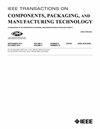总线方向约束下的总线感知有序逃逸路由
IF 3
3区 工程技术
Q2 ENGINEERING, ELECTRICAL & ELECTRONIC
IEEE Transactions on Components, Packaging and Manufacturing Technology
Pub Date : 2025-04-07
DOI:10.1109/TCPMT.2025.3558532
引用次数: 0
摘要
众所周知,有序逃逸布线在印刷电路板(PCB)设计中变得越来越重要。本文给出了在一个引脚阵列内的一组具有若干受总线方向约束的总线的逃逸引脚、一组可用边界以及相邻两引脚之间的容量约束,从而可以构造出总线方向约束下的总线感知有序逃逸路由(BOER),并提出了一种有效的算法来解决路由问题。在给定总线的有序逃逸布线中,根据具有总线方向约束的任何总线的逃逸引脚位置,首先将总线内未路由网的目标引脚分配到约束边界上以实现长度最小化,然后再对总线内未路由网进行进一步路由以实现偏差最小化。在对剩余网进行有序逃逸路由时,根据给定总线作为障碍物的路由结果和剩余路由空间的划分,可先将剩余未路由的网划分为若干网集,任一网集内的网可进一步路由到其特定的路由区域内。与Luo的基于sat的算法、Jiao的基于流量的算法和Yan的不考虑总线方向的算法相比,该算法可以获得100%的逃逸网可达性,在容量为1的6个测试例中,平均减少38.6%、34.4%和28.9%的违规总线数量。此外,与不考虑总线方向的Yan算法相比,本文算法也可以实现100%的逃逸网可达性,并且在容量为2的其他6个测试示例中,平均减少了37.3%的违规总线数量。本文章由计算机程序翻译,如有差异,请以英文原文为准。
Bus-Aware Ordered Escape Routing Under Bus-Direction Constraints
It is known that ordered escape routing becomes more important in printed circuit board (PCB) designs. In this article, given a set of escape pins with some buses under bus-direction constraints inside a pin array, a set of available boundaries, and the capacity constraint between two adjacent pins, bus-aware ordered escape routing (BOER) under bus-direction constraints can be formulated and an efficient algorithm can be proposed to solve the routing problem. In ordered escape routing for the given buses, based on the locations of the escape pins for any bus with its bus-direction constraint, the target pins of the unrouted nets inside the bus can be first assigned onto the constrained boundary for length minimization and the unrouted nets inside the bus can be further routed for skew minimization. In ordered escape routing for the remaining nets, based on the routing results of the given buses as obstacles and the division of the remaining routing space, the remaining unrouted nets can be first partitioned into some net sets and the nets inside any net set can be further routed inside its specific routing region. Compared with Luo’s SAT-based algorithm, Jiao’s flow-based algorithm, and Yan’s algorithm with no bus-direction consideration, the proposed algorithm can obtain the 100% routability of the escape nets and reduces 38.6%, 34.4%, and 28.9% of the number of the violated buses on the average for the six tested examples with capacity as 1, respectively. Additionally, compared with Yan’s algorithm with no bus-direction consideration, the proposed algorithm can also achieve 100% routability of the escape nets and reduces 37.3% of the number of the violated buses on the average for the other six tested examples with capacity as 2.
求助全文
通过发布文献求助,成功后即可免费获取论文全文。
去求助
来源期刊

IEEE Transactions on Components, Packaging and Manufacturing Technology
ENGINEERING, MANUFACTURING-ENGINEERING, ELECTRICAL & ELECTRONIC
CiteScore
4.70
自引率
13.60%
发文量
203
审稿时长
3 months
期刊介绍:
IEEE Transactions on Components, Packaging, and Manufacturing Technology publishes research and application articles on modeling, design, building blocks, technical infrastructure, and analysis underpinning electronic, photonic and MEMS packaging, in addition to new developments in passive components, electrical contacts and connectors, thermal management, and device reliability; as well as the manufacture of electronics parts and assemblies, with broad coverage of design, factory modeling, assembly methods, quality, product robustness, and design-for-environment.
 求助内容:
求助内容: 应助结果提醒方式:
应助结果提醒方式:


